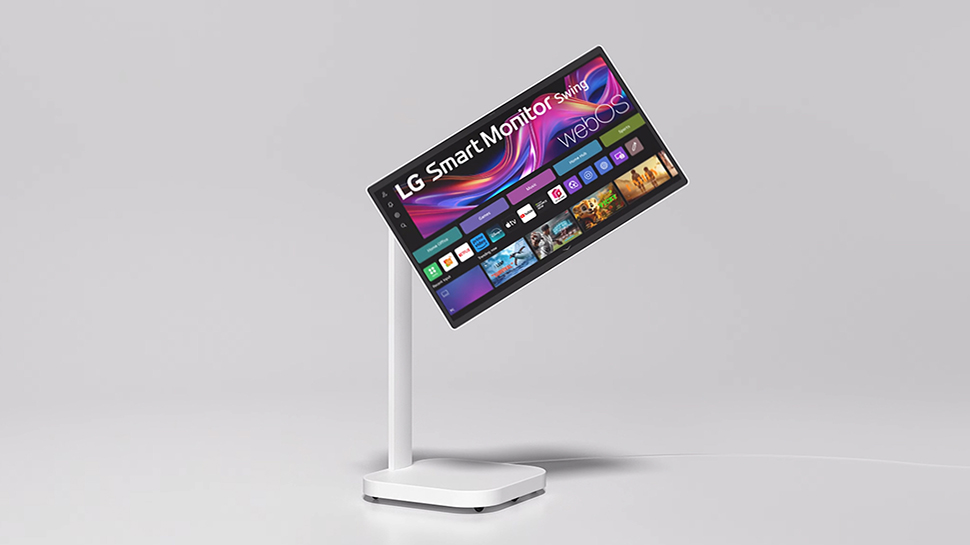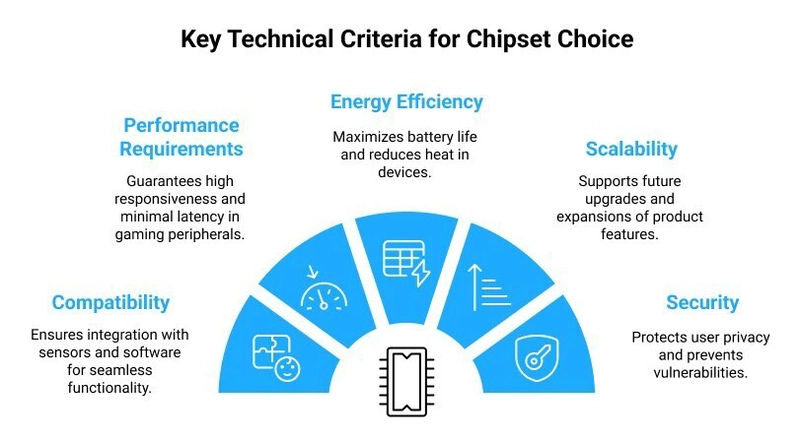Struggling to Choose the Right Chipset for Your Gaming Gear? Developex Guide + Database Will Help
Choosing the right chipset is one of the most critical decisions in the development of gaming peripherals, including keyboards, mice, and other accessories. The chipset acts as the brain of your device and significantly impacts performance, sensitivity, energy efficiency, and user experience. It’s essential to get it right to ensure your product meets the high demands of gamers. In this guide, we’ll walk you through the key factors to consider when selecting a chipset for your gaming peripherals. Plus, as a special bonus, you’ll get free access to our exclusive Chipset Database, a valuable resource with chipset specifications from top vendors. What is a Chipset and Why Does It Matter for Gaming Peripherals? A chipset is a group of microchips responsible for managing the data flow between the processor, memory, sensors, and other peripherals. In gaming peripherals, the chipset is critical because it ensures seamless communication between the device and the computer or console. The performance and responsiveness of your keyboard or mouse largely depend on the chipset selected. Role of a Chipset in a Gaming Peripheral Ecosystem For gaming peripherals, the chipset is more than just a “connector”—it defines how your device communicates with the system, determines processing speeds, and enables features like RGB lighting, custom macros, DPI adjustments, and low-latency modes. Without the right chipset, even the most innovative designs can fall short in terms of performance and user experience. Key Functions of a Chipset in Gaming Peripherals A chipset manages data flow between the processor, memory, sensors, and other components, ensuring seamless communication between the peripheral and the gaming system. Key roles of the chipset include: Data Flow Management: Coordinates communication between key components for smooth operation. Low-Latency Communication: Ensures fast input processing with minimal delay, crucial for gaming. Sensor and Actuator Control: Manages sensor data for accurate tracking and keypress detection. Energy Efficiency: Optimizes power usage, extending battery life for wireless devices. Customization: Supports customizable settings like DPI profiles and macros. Reliability: Ensures stable, durable performance for prolonged gaming sessions. Chipset Impact on Performance and and User Experience The right chipset is vital for both the hardware performance and the software ecosystem of gaming peripherals. It influences key aspects like responsiveness, precision, and customization options, ensuring smooth gameplay with minimal input lag and accurate tracking. Additionally, a well-chosen chipset enhances software compatibility, supporting features like macros, RGB lighting control, and wireless connectivity. On the other hand, a poor chipset selection can lead to sluggish performance, limited functionality, and scalability issues, affecting both the gaming experience and future product development. Ultimately, the right chipset ensures a seamless user experience and keeps your product competitive in the gaming market. That`s why it’s essential to understand your product’s specific needs and how different chipsets align with those requirements. From there, evaluating multiple vendors and testing options will help you identify the best solution. The right choice not only delivers strong performance today but also sets the stage for future upgrades, ensuring your product stays relevant as technology and user expectations evolve. Key Factors to Consider When Choosing a Chipset for Gaming Peripherals The chipset you choose for your gaming peripherals plays a significant role in how your product performs and how well it resonates with gamers. It impacts everything from the device’s responsiveness to its energy efficiency. To ensure the best outcome, you need to balance both business and technical factors. Below, we’ll explore the essential considerations to guide you through the selection process. Business and Market Considerations While performance is a key aspect, the chipset you choose should also fit within your broader business strategy. This includes evaluating market opportunities, understanding production constraints, and ensuring long-term availability. In this section, we’ll highlight the business considerations that will help you make the right chipset choice to support both your product’s performance and your company’s long-term goals. Sales Volume & Vendor Negotiation: The potential market size and ability to negotiate with chipset suppliers should be a primary consideration. Manufacturing Capabilities: Ensure the chipset aligns with the capabilities, testing processes, and production facilities of the factory you plan to use. Documentation & Support: Availability of detailed documentation, technical support, and the status of the SOC/MCU are key factors. Industry Usage: Check if the chipset has been su

Choosing the right chipset is one of the most critical decisions in the development of gaming peripherals, including keyboards, mice, and other accessories. The chipset acts as the brain of your device and significantly impacts performance, sensitivity, energy efficiency, and user experience. It’s essential to get it right to ensure your product meets the high demands of gamers.
In this guide, we’ll walk you through the key factors to consider when selecting a chipset for your gaming peripherals. Plus, as a special bonus, you’ll get free access to our exclusive Chipset Database, a valuable resource with chipset specifications from top vendors.
What is a Chipset and Why Does It Matter for Gaming Peripherals?
A chipset is a group of microchips responsible for managing the data flow between the processor, memory, sensors, and other peripherals. In gaming peripherals, the chipset is critical because it ensures seamless communication between the device and the computer or console. The performance and responsiveness of your keyboard or mouse largely depend on the chipset selected.
Role of a Chipset in a Gaming Peripheral Ecosystem
For gaming peripherals, the chipset is more than just a “connector”—it defines how your device communicates with the system, determines processing speeds, and enables features like RGB lighting, custom macros, DPI adjustments, and low-latency modes. Without the right chipset, even the most innovative designs can fall short in terms of performance and user experience.
Key Functions of a Chipset in Gaming Peripherals
A chipset manages data flow between the processor, memory, sensors, and other components, ensuring seamless communication between the peripheral and the gaming system. Key roles of the chipset include:
- Data Flow Management: Coordinates communication between key components for smooth operation.
- Low-Latency Communication: Ensures fast input processing with minimal delay, crucial for gaming.
- Sensor and Actuator Control: Manages sensor data for accurate tracking and keypress detection.
- Energy Efficiency: Optimizes power usage, extending battery life for wireless devices.
- Customization: Supports customizable settings like DPI profiles and macros.
- Reliability: Ensures stable, durable performance for prolonged gaming sessions.
Chipset Impact on Performance and and User Experience
The right chipset is vital for both the hardware performance and the software ecosystem of gaming peripherals. It influences key aspects like responsiveness, precision, and customization options, ensuring smooth gameplay with minimal input lag and accurate tracking. Additionally, a well-chosen chipset enhances software compatibility, supporting features like macros, RGB lighting control, and wireless connectivity.
On the other hand, a poor chipset selection can lead to sluggish performance, limited functionality, and scalability issues, affecting both the gaming experience and future product development. Ultimately, the right chipset ensures a seamless user experience and keeps your product competitive in the gaming market.
That`s why it’s essential to understand your product’s specific needs and how different chipsets align with those requirements. From there, evaluating multiple vendors and testing options will help you identify the best solution. The right choice not only delivers strong performance today but also sets the stage for future upgrades, ensuring your product stays relevant as technology and user expectations evolve.
Key Factors to Consider When Choosing a Chipset for Gaming Peripherals
The chipset you choose for your gaming peripherals plays a significant role in how your product performs and how well it resonates with gamers. It impacts everything from the device’s responsiveness to its energy efficiency. To ensure the best outcome, you need to balance both business and technical factors. Below, we’ll explore the essential considerations to guide you through the selection process.
Business and Market Considerations
While performance is a key aspect, the chipset you choose should also fit within your broader business strategy. This includes evaluating market opportunities, understanding production constraints, and ensuring long-term availability. In this section, we’ll highlight the business considerations that will help you make the right chipset choice to support both your product’s performance and your company’s long-term goals.
- Sales Volume & Vendor Negotiation: The potential market size and ability to negotiate with chipset suppliers should be a primary consideration.
- Manufacturing Capabilities: Ensure the chipset aligns with the capabilities, testing processes, and production facilities of the factory you plan to use.
- Documentation & Support: Availability of detailed documentation, technical support, and the status of the SOC/MCU are key factors.
- Industry Usage: Check if the chipset has been successfully implemented in similar products or by competitors.
- Marketing & Feature Complexity: Strike the right balance between feature richness and complexity in implementation.
- Chipset Lifecycle: Consider the long-term availability and support for the chipset to avoid obsolescence issues.
- Developer Experience: Assess the availability of developers with experience in the chosen chipset to streamline integration and development.
Technical Characteristics
While business factors are important, the chipset’s technical features directly affect your product’s performance, efficiency, and user experience. A well-chosen chipset ensures smooth integration with sensors, switches, and communication interfaces while meeting the specific needs of gaming peripherals. Below are the technical factors you must consider when selecting a chipset.
Compatibility
The chipset must work with other components like sensors, switches, LEDs, and communication interfaces (e.g., Bluetooth or wired). For example, a high-end gaming mouse with RGB lighting requires a chipset that supports power management and lighting control integration. It should also be compatible with software for driver integrations like key mapping and DPI settings.
Performance Requirements
Gaming peripherals need high responsiveness and minimal latency. For instance, gaming mice require chipsets that handle high DPI settings, while mechanical keyboards need chipsets that detect key presses quickly without input lag. The right chipset ensures smooth, reliable performance during intense gaming sessions, especially in competitive environments.
Energy Efficiency
For wireless devices, a high-performance chipset should ensure extended battery life without sacrificing responsiveness. Look for energy-saving modes or smart power management to reduce battery drain during inactivity. For wired devices, efficient power management is key to reducing heat and ensuring long-term reliability.
Scalability
As your product evolves, the chipset should support future upgrades or expansions. Ensure the chipset can support future upgrades or expansions, such as higher sensor sensitivity or additional RGB customization. It should also handle software updates or new features like programmable macros or cloud-syncing, ensuring long-term adaptability in a fast-evolving market.
Security
Security is becoming more important in gaming peripherals. A chipset with secure communication protocols (for wireless devices) or data encryption can protect user privacy and prevent vulnerabilities. For instance, a wireless gaming mouse should have a chipset that ensures secure connections to avoid unauthorized access or interference. Security also safeguards customization data or user profiles stored on the device.
Cost vs. Benefit
Balancing cost with performance is essential. A cheaper chipset may reduce initial costs but can lead to poor responsiveness or limited features. On the other hand, a high-end chipset may offer premium features but could be costly for the average user. Assess the chipset’s benefits to ensure it meets your market’s expectations without exceeding the budget.
Migration Between Chipsets Within the Same Series
While the goal is to select the optimal chipset from the start, there are scenarios where transitioning to another chipset within the same series may be beneficial. If, during development or even in production, it becomes evident that a chosen chipset has excess performance, memory, or pin availability, switching to a lower-spec version can help reduce the final product’s cost.
Since the new chipset would be from the same manufacturer and product line, firmware modifications would be minimal, making the transition both cost-effective and practical. In high-volume manufacturing, this adjustment can lead to significant savings while maintaining software compatibility and minimizing development effort. Strategic chipset selection with built-in scalability ensures flexibility in optimizing product costs without sacrificing functionality.
Explore the Chipset Database – A Valuable Resource for Gaming Peripheral Brands
With over 15 years of experience in developing custom firmware and software for gaming peripherals, Developex supports manufacturers in creating high-performance solutions for mice, keyboards, and other gaming gear. From firmware development to communication protocols and testing, we ensure that each gaming device delivers precise control, low latency, and a seamless experience. Our extensive expertise helps manufacturers build products that keep gamers at the top of their game.
To support product teams, engineers, and decision-makers working on gaming devices, we’ve created a Chipset Database tailored specifically for mice, keyboards, and other peripherals. It includes detailed specifications, performance benchmarks, power efficiency, and compatibility insights for a wide range of chipsets from leading vendors. This resource is designed to help you compare options and make informed decisions faster.
Want access to the database? Just fill out the form — and we’ll send it your way.
Why Trust Developex for Gaming Peripherals Development?
When it comes to gaming peripherals, selecting the right chipset is just the start. What matters most is having a partner who can turn that choice into a high-performance, reliable product.
Developex brings the expertise and commitment to help turn your vision into a high-performance, reliable device. From the initial concept to final integration, we provide the support necessary to deliver seamless user experiences, allowing your gaming peripherals to stand out in a competitive market.
What sets us apart:
- Industry Expertise: We understand the intricacies of gaming hardware and the specific demands of gaming peripherals.
- Vendor- Neutral Recommendations: Our guidance is impartial, ensuring the best fit for both your technical needs and business goals.
- Full-Cycle Support: We assist with everything, from chipset selection and testing to firmware development and system integration, ensuring seamless execution. By partnering with Developex, you gain a dedicated ally in transforming your ideas into exceptional products.
Conclusion
Choosing the right chipset is crucial to the performance and success of your gaming peripherals. It impacts everything from responsiveness and battery life to customization and security. By considering key factors such as compatibility, performance, energy efficiency, and scalability, you’re already on the right path.
To make the final decision easier, we’ve put together our exclusive Chipset Database, packed with detailed comparisons of chipsets from top vendors.
Want access? Fill out the form or email us to get your free copy today.









































































































































































![[The AI Show Episode 144]: ChatGPT’s New Memory, Shopify CEO’s Leaked “AI First” Memo, Google Cloud Next Releases, o3 and o4-mini Coming Soon & Llama 4’s Rocky Launch](https://www.marketingaiinstitute.com/hubfs/ep%20144%20cover.png)

































































































































![[DEALS] Sterling Stock Picker: Lifetime Subscription (85% off) & Other Deals Up To 98% Off – Offers End Soon!](https://www.javacodegeeks.com/wp-content/uploads/2012/12/jcg-logo.jpg)












































































































.jpg?#)




















































































































































![Apple to Shift Robotics Unit From AI Division to Hardware Engineering [Report]](https://www.iclarified.com/images/news/97128/97128/97128-640.jpg)

![Apple Shares New Ad for iPhone 16: 'Trust Issues' [Video]](https://www.iclarified.com/images/news/97125/97125/97125-640.jpg)





































































































































